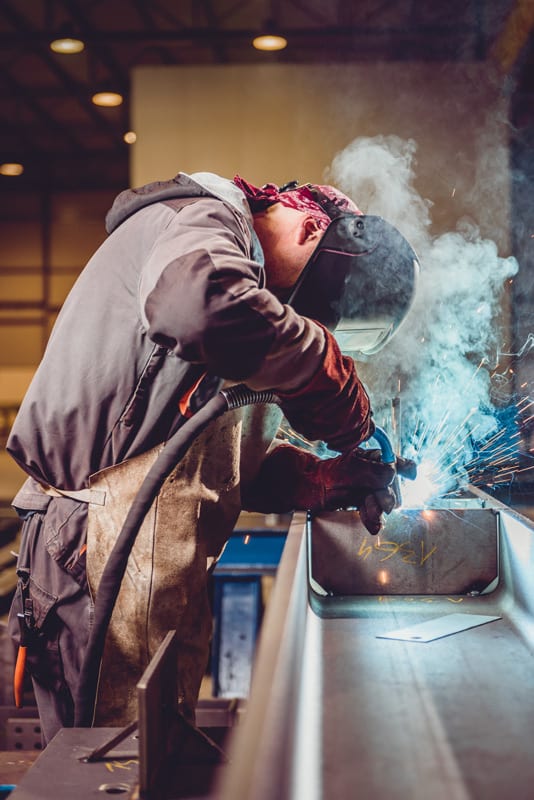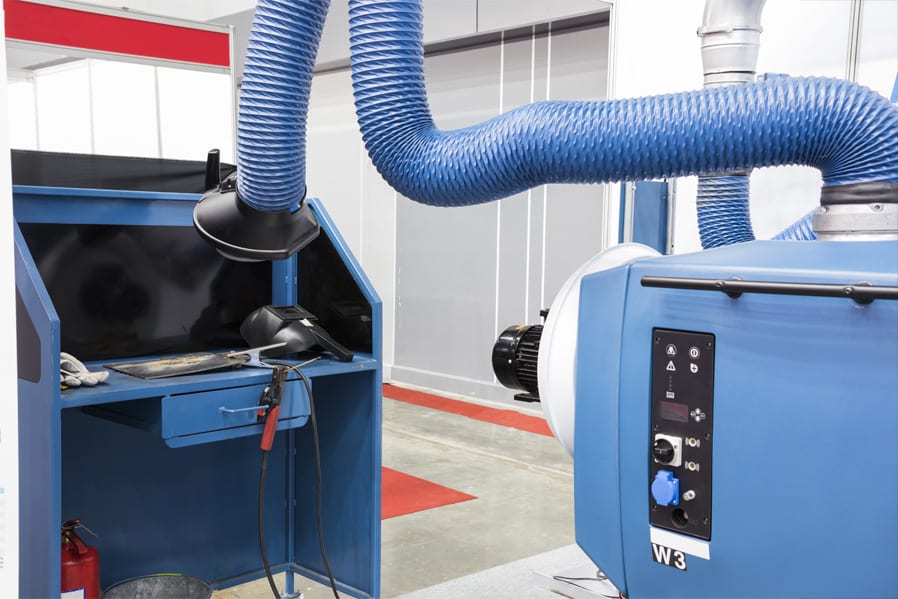EXPOSURE TO WELDING FUMES AND OTHER GASES
There are many types of welding processes that can cause exposure to harmful gases and fumes. The visible clouds of fume are generally made up of metal particles and metal oxide. Additionally, harmful gases such as nitrous oxide, carbon monoxide and carbon dioxide are emitted during welding operations. In order to protect workers these gases and fumes need to be controlled. A fume extraction system could be the perfect solution.
ARE WELDING FUMES TOXIC?
Each welding process gives off various amounts of harmful fumes and gases that contain small particles of metal particles and metal oxide. Welding operations can emit toxic gases such as nitrous oxide, carbon monoxide and carbon dioxide.
Brief exposure to welding fumes can cause side effects such as dizziness, nausea, and irritation, requiring the worker to leave the area, get fresh air, and seek medical attention. Prolonged exposure can also lead to more severe conditions such as nervous system damage, lung damage and numerous types of cancer.
WHY IS FUME CONTROL NECESSARY?
Each different type of welding process gives off varying amounts of harmful fumes and gases. Fumes contain small particles of metal and flux, carbon monoxide and carbon dioxide. Studies by the HSE have concluded that welding fumes may be more harmful that previously thought: exposure to these fumes can cause many respiratory illnesses or even cancer. Companies must now provide adequate controls for welding operations regardless of duration. Additionally, these controls should remove the hazard at source as overall room extraction does not reduce exposure to the operator. A fume extraction system could present the ideal solution.
FUME EXTRACTION WORKPLACE EXPOSURE LIMIT
The workplace exposure limit (WEL) for welding fumes varies depending on the type of welding, material and the filler rod and flux. For example, the 8 hour exposure limit for iron oxide is 5mg/m3, whilst the limit for chromium III is 0.5mg/m3. Because of the large differences in WELs and combinations of different welding processes, we recommend that exposure tests are carried out to determine your limits. For information regarding the WEL for specific welding operation visit the HSE website. Extraction Solutions can offer bespoke fume extraction solutions to cater for your precise needs.
HOW DOES FUME EXTRACTION WORK?
Fume control measures capture the gases and fumes before reaching the user’s breathable space. When planning the fume control measures, conduct risk assessments to identify workplace hazards, involve the employees and prioritise their safety. The workforce will readily adopt a user-friendly industrial fume extraction system that does not impede workflow.


HOW TO CONTROL EXPOSURE
Workplace hazards should all be taken into consideration when planning control measures. Protection of the worker should always be the first priority and employees should be included in the planning process. A fume system that is easy to use and does not impede workflow will be readily adopted by the workforce. We recommend a a combination of a centralised LEV and small portable welding extractors that can cover all aspects of your operations.
A LEV system coupled with easily manoeuvrable extraction hoods offers total flexibility and control for the operator. This allows them to position the hood as they move along the work piece and removing the toxic fumes at source before they can enter breathable space. General or overall extraction of a room is not generally accepted because this does not prevent the fumes reaching the operator. Risk assessments should be carried out in order to identify risks and implement control measures.
ASSESSING FUME RISKS
When dealing with harmful substances, a risk assessment should be completed. We have put together an example on how you can evaluate your processes.
#1 Identify the Risks
The first part of any risk assessment should be to identify the hazards in your work area#1 Identify the Risks
Analyse processes in your workplace and identify potential hazards. What harmful fumes are being emitted? Who is this effecting and how far reaching is the exposure?
#2 Frequency of Use
Frequency of use is important when determining how to tackle control#2 Frequency of Use
If an operator is welding in an open area for an hour, RPE could be used, but long term welding operations should be controlled using more permanent measures like a fume extraction system.
#3 Change the Process
Are there safer materials or processed that could be used?#3 Change the Process
Identify where it’s possible to change processes to reduce exposure to fumes. Could a different material be used such as a pre-cut or pre-finished material for the welding?
#4 Which Controls Work
Determine if and what controls should be implemented to reduce the risk#4 Which Controls Work
Based on the information identify the controls best suited to your environment, such as fume extraction. RPE can be considered as a last resort.
#5 Consider PPE/RPE
This should be the last resort when identifying control measures#5 Consider PPE/RPE
If there are no other methods available to control the fume and the process can’t be changed, then PPE/RPE can be considered. A separate risk assessment should be undertaken.
GET IN TOUCH WITH US
Fill in the form and we’ll get back to you!
